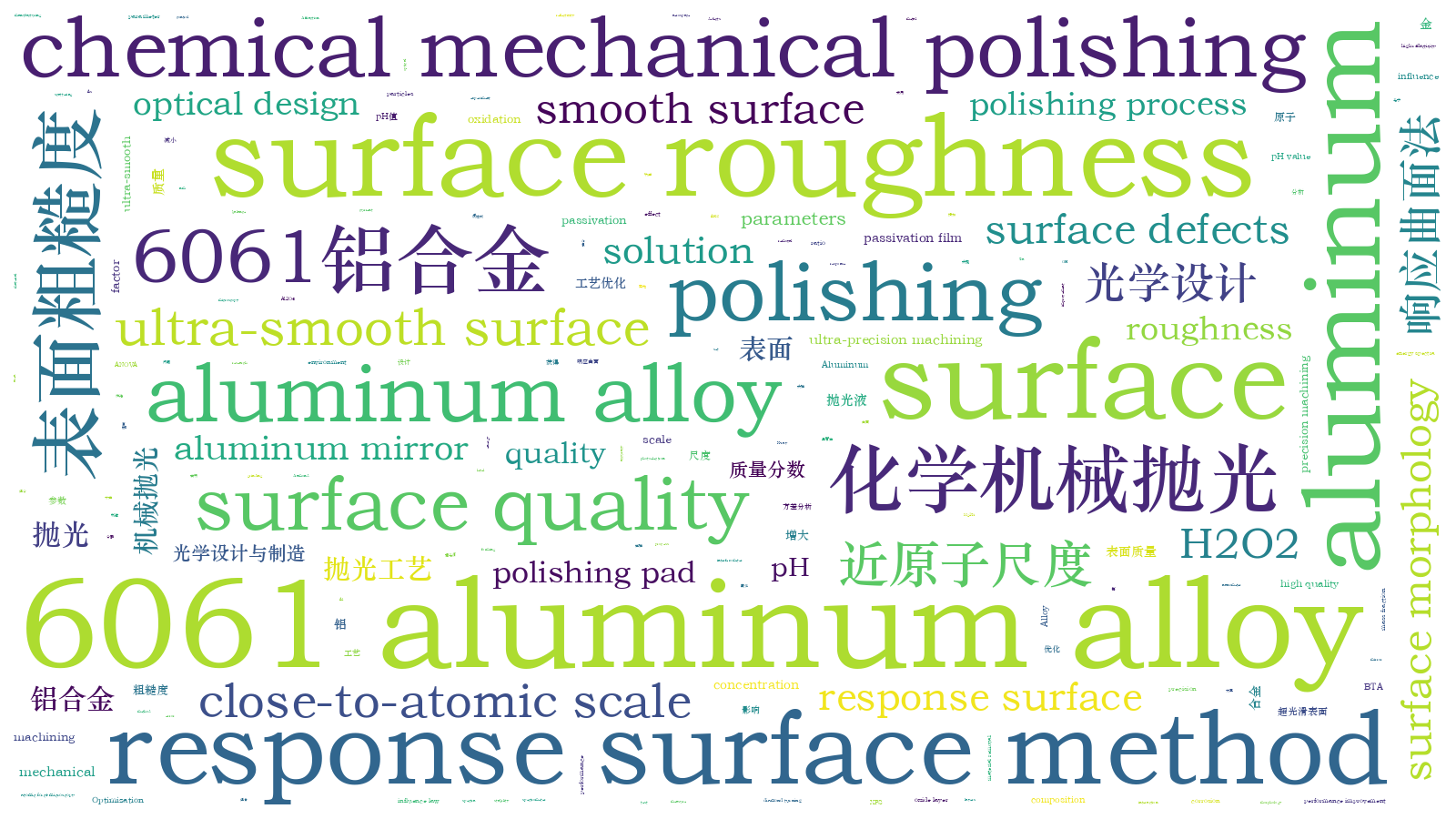6061铝合金近原子尺度化学机械抛光工艺优化
6061 aluminum alloy is widely employed in aerospace, optical manufacturing, and other fields in the production of mirrors due to its high reflectivity, easy machining, and sound stability after forming. However, at present, the surface roughness of aluminum mirrors using grinding and diamond turning machining methods is large, and the diffraction and scattering effects are too serious, which reduces the performance of aluminum mirrors. As an ultra-precision machining technology to obtain high quality surface, chemical mechanical polishing technology has been widely studied in the polishing of aluminum and its alloys. However, due to the presence of Mg2Si hard particles and other elements in 6061 aluminum alloy, it is difficult to obtain ultra-smooth surfaces at present, and the influence of various parameters on the polishing process is still unclear. To this end, we investigate the influence of the parameters in the polishing solution on the surface quality of 6061 aluminum alloy and optimize a chemical mechanical polishing solution for 6061 aluminum alloy. The polishing solution can remove surface defects and obtain a good surface with a surface roughness of less than 0.4 nm. Therefore, our research can fill the current gap in the ultra-precision machining of 6061 aluminum alloy and contribute to the performance improvement of aluminum alloy mirrors.
Firstly, the chemical mechanical polishing experiments of 6061 aluminum alloy are carried out by single factor control of different oxidant H2O2, corrosion inhibitor BTA concentration, and pH from acidity to alkaline in the polishing solution. After polishing, the Zygo interferometer is adopted to characterize the surface morphology and roughness to explore the effect of each parameter acting alone. Then, according to the influence law of each single factor, based on the response surface method (RSM), we set up a three-factor, three-level experiment, and utilize ANOVA to test the effect of degree of each parameter on the surface quality. The surface composition of the aluminum part is measured by an X-ray photoelectron spectrometer (XPS) and the interaction of parameters is analyzed to predict the composition ratio of the polishing solution which can obtain the best surface quality. Finally, atomic force microscopy (AFM) is leveraged to further measure the surface roughness after polishing and evaluate the accuracy of the predicted results.
The surface quality of 6061 aluminum alloy is poor when only abrasive grains and pH alone act (Fig. 4), which helps further reduce the surface roughness after adding a certain concentration of H2O2. However, the surface inevitably produces deeper craters (Fig. 6), the surface quality is significantly improved with the addition of BTA, and the surface roughness is reduced to a sub-nanometer scale (Fig. 8). This is because aluminum as an amphoteric metal corrodes severely with both acids with too small a pH and bases with a large pH, and neutral aluminum is difficult to remove as it is too stable. After adding H2O2 and BTA, the aluminum first acts with H2O2 in a weak alkaline environment to promote the oxidation reaction of aluminum, thus generating Al2O3, AlOOH, and Al(OH)3 oxide layers (Fig. 10). Then BTA forms a passivation film on the oxide layer surface. The raised area on the surface of the aluminum parts makes it easy to contact with the abrasive particles and polishing pad to achieve material removal. However, the pits are protected from excessive corrosion by the passivation film to achieve local ultra-smooth polishing (Fig. 11). Finally, RSM is adopted to optimize the composition ratio of the polishing solution to achieve a balance between oxidation reaction, passivation reaction, and mechanical action during the polishing. The ultra-smooth surface of 6061 aluminum alloy at a close-to-atomic scale is achieved (Fig. 12).
The effects of various parameters on the chemical mechanical polishing of 6061 aluminum alloy are studied and a polishing solution for close-to-atomic scale polishing of 6061 aluminum alloy surface is optimized. The results of single-factor experiments show that 6061 aluminum alloy can obtain the best surface quality when pH is in weak alkalinity, and the surface roughness decreases first and then increases with the rising H2O2 and BTA concentration. XPS energy spectra show that H2O2 in a certain concentration in the polishing solution can promote aluminum oxidation under the alkaline environment, and BTA can form a passivation film based on the oxide layer to inhibit the oxidation. The optimized polishing solution parameters include a pH value of 9.7, a H2O2 mass fraction of 0.57%, and a BTA mass fraction of 1.16%, and the surface roughness of the aluminum mirror decreases from 140 nm to 0.31 nm. The error with the predicted value of RSM is less than 10%, and the ultra-smooth surface close-to-atomic scale is obtained.
郭江, 徐海俊, 杨哲, 王磊, 赵宏鑫. 6061铝合金近原子尺度化学机械抛光工艺优化[J]. 光学学报, 2024, 44(5): 0522001. Jiang Guo, Haijun Xu, Zhe Yang, Lei Wang, Hongxin Zhao. Optimization of Chemical Mechanical Solution for Close-to-Atomic Scale Polishing of 6061 Aluminum Alloy[J]. Acta Optica Sinica, 2024, 44(5): 0522001.







